The ASUS X99-E-10G WS Motherboard Review: 10GBase-T Networking with Intel’s X550-AT2
by Ian Cutress on November 7, 2016 9:00 AM EST- Posted in
- Motherboards
- Intel
- Asus
- 10G Ethernet
- X99
- 10GBase-T
- X99-E-10G WS
- X550
- X550-AT2
CPU Performance, Short Form
For our motherboard reviews, we use our short form testing method. These tests usually focus on if a motherboard is using MultiCore Turbo (the feature used to have maximum turbo on at all times, giving a frequency advantage), or if there are slight gains to be had from tweaking the firmware. We leave the BIOS settings at default and memory at JEDEC (DDR4-2133 C15) for these tests, making it very easy to see which motherboards have MCT enabled by default.
Video Conversion – Handbrake v0.9.9: link
Handbrake is a media conversion tool that was initially designed to help DVD ISOs and Video CDs into more common video formats. For HandBrake, we take two videos (a 2h20 640x266 DVD rip and a 10min double UHD 3840x4320 animation short) and convert them to x264 format in an MP4 container. Results are given in terms of the frames per second processed, and HandBrake uses as many threads as possible.
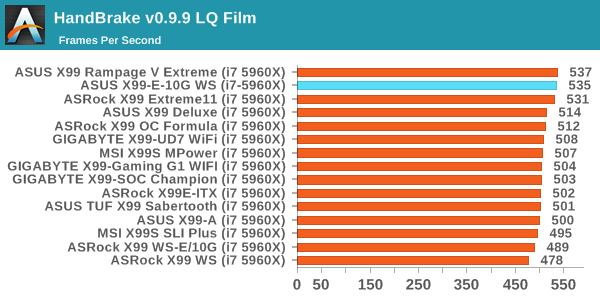
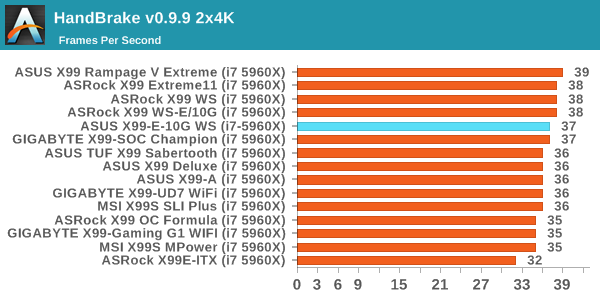
Compression – WinRAR 5.0.1: link
Our WinRAR test from 2013 is updated to the latest version of WinRAR at the start of 2014. We compress a set of 2867 files across 320 folders totaling 1.52 GB in size – 95% of these files are small typical website files, and the rest (90% of the size) are small 30 second 720p videos.
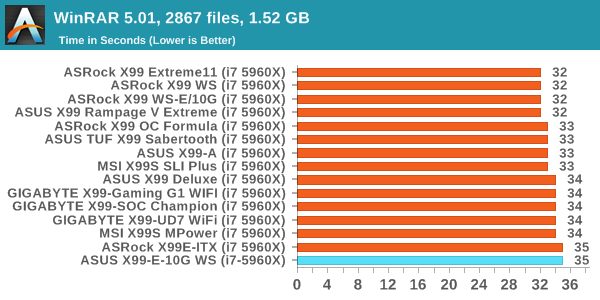
Point Calculations – 3D Movement Algorithm Test: link
3DPM is a self-penned benchmark, taking basic 3D movement algorithms used in Brownian Motion simulations and testing them for speed. High floating point performance, MHz and IPC wins in the single thread version, whereas the multithread version has to handle the threads and loves more cores. For a brief explanation of the platform agnostic coding behind this benchmark, see my forum post here.
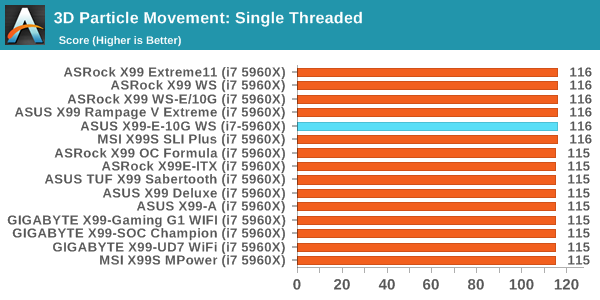

Rendering – POV-Ray 3.7: link
The Persistence of Vision Ray Tracer, or POV-Ray, is a freeware package for as the name suggests, ray tracing. It is a pure renderer, rather than modeling software, but the latest beta version contains a handy benchmark for stressing all processing threads on a platform. We have been using this test in motherboard reviews to test memory stability at various CPU speeds to good effect – if it passes the test, the IMC in the CPU is stable for a given CPU speed. As a CPU test, it runs for approximately 2-3 minutes on high end platforms.
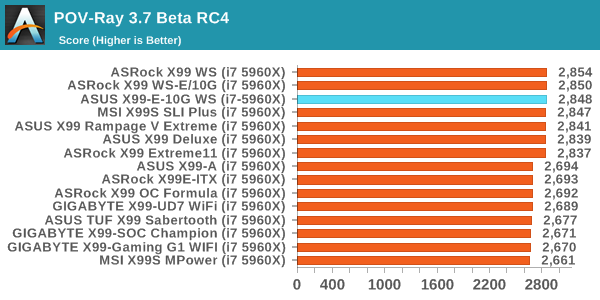
Synthetic – 7-Zip 9.2: link
As an open source compression tool, 7-Zip is a popular tool for making sets of files easier to handle and transfer. The software offers up its own benchmark, to which we report the result.
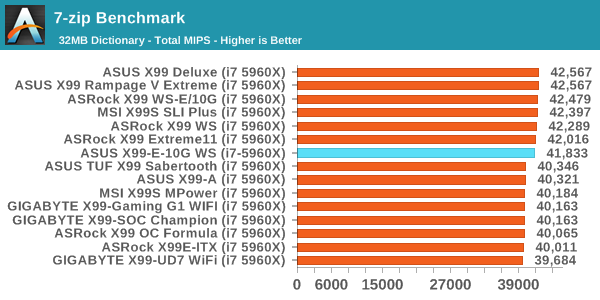










63 Comments
View All Comments
dsumanik - Monday, November 7, 2016 - link
Agreed, but there is a lot of PCI lane juggling on this board as is. With the amount of modern external and internal interfaces being pushed currently the days of 'one board to do it all' may be gone forever, sadly.Ultimately this board is going to appeal to users who want to use PCI Slots taken up by 10g rider cards in thier current rigs.
IMO the idle power is a bit of a concern, over the life of the board it is going to add up, especially if used for server duties.
Notmyusualid - Friday, December 2, 2016 - link
Yes I noticed that too - hence I just picked up a new ASRock ws-e/10G which has the Thunderbolt header (TB2 I think it is - but that is fine with me). But what I didn't expect, was that I'd need to BUY the pcie card to actually present the interface. I must admit, I expected something like that to be in the box. More expense.Just waiting for my E5-2690v4 Broadwell-EP 14-Core 135W 35M CPU to clear customs to check it all out...
sorten - Monday, November 7, 2016 - link
what is the use case for 10G in the home?jkhoward - Monday, November 7, 2016 - link
People who render using multiple workstations want a super fast network. You can chain multiple systems together to render something faster. Think... home graphic designed/video editor.timbotim - Monday, November 7, 2016 - link
My primary use case is 30sec transfer of VMs around a network at 10Gbs-1 rather than 5mins at 1Gbs-1beginner99 - Tuesday, November 8, 2016 - link
Thats a niche use case and you will need a PCIe SSD to write that much data in such a short time. A 20 GB VM would require a write speed of about 680Mb/s.sorten - Monday, November 7, 2016 - link
I see, so the average consumer running a render farm in their home office ;-)philehidiot - Tuesday, November 8, 2016 - link
Personally, I tend to render farts in my home office.I do not require quite so many PCIe lanes for this.
slyphnier - Wednesday, November 9, 2016 - link
that not cost efficient for home graphic designer/video editor, because u end up spend like more than $15k(depends on many ws) for multiple ws including the switch/router... even say your system/rig will last you like 3-4 years, that will be much cheaper go with rental rendering server/office routei believe this board is limited, with shop that have this & available quantity
Notmyusualid - Friday, December 2, 2016 - link
They ARE limited, I cannot find waterblocks for mine... But, I can live with that.At least having your own hardware, its a KNOWN cost, and some provider doesn't contact you to notify you that you own $7k usd this month in network over-usage due to some redirection error you made...